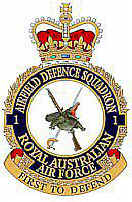Airfield Defence Guards (ADG) are a mustering of the Royal Australian Air Force (RAAF) that are dedicated to the security and ground defence of airbases and other military aviation assets. Other duties include training other RAAF personnel, in skills such as the handling of small arms and infantry tactics. They do not, however, operate anti-aircraft artillery or missiles.

RAAF Base Darwin is a Royal Australian Air Force (RAAF) military air base located in the city of Darwin, in the Northern Territory, Australia. The base shares its runway with Darwin International Airport, for civil aviation purposes. The heritage-listed RAAF Base Darwin is a forward operating base with year-round activity with approximately 400 personnel.

No. 3 Squadron is a Royal Australian Air Force (RAAF) fighter squadron, headquartered at RAAF Base Williamtown, near Newcastle, New South Wales. Established in 1916, it was one of four combat squadrons of the Australian Flying Corps during World War I, and operated on the Western Front in France before being disbanded in 1919. It was re-raised as a permanent squadron of the RAAF in 1925, and during World War II operated in the Mediterranean Theatre. The Cold War years saw the squadron disbanded and re-raised twice. It was based at RAAF Butterworth during the Malayan Emergency and the Indonesia–Malaysia Konfrontasi. Equipped with McDonnell Douglas F/A-18 Hornet multi-role fighters from 1986, the squadron deployed to Diego Garcia in 2002 to provide local air defence, and the following year contributed aircraft and crews to the invasion of Iraq as part of Operation Falconer. In April 2016, it deployed to the Middle East as part of the military intervention against ISIL.
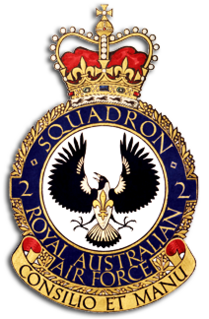
No. 2 Squadron is a Royal Australian Air Force (RAAF) squadron that operates from RAAF Base Williamtown, near Newcastle, New South Wales. From its formation in 1916 as part of the Australian Flying Corps, it has flown a variety of aircraft types including fighters, bombers, and Airborne Early Warning & Control (AEW&C). During World War I, the squadron operated on the Western Front conducting fighter sweeps and ground-attack missions. It was disbanded in mid-1919, following the end of hostilities. The squadron was briefly re-raised in 1922 as part of the newly independent RAAF, but was disbanded after only a couple of months and not reformed until 1937. It saw action as a bomber unit in the South West Pacific theatre of World War II and, equipped with English Electric Canberra jets, in the Malayan Emergency and the Vietnam War. The squadron was again disbanded in 1982, following the retirement of the Canberra. It was re-formed in 2000 to operate the Boeing 737 AEW&C "Wedgetail". One of the six Boeing 737s was deployed to the Middle East in September 2014, as part of Australia's contribution to the military coalition against ISIS.

No. 79 Squadron is a Royal Australian Air Force (RAAF) flight training unit that has been formed on four occasions since 1943. The squadron was established in May 1943 as a fighter unit equipped with Supermarine Spitfires, and subsequently saw combat in the South West Pacific theatre of World War II. Between June 1943 and the end of the war in August 1945 it flew air defence patrols to protect Allied bases and ships, escorted Australian and United States aircraft, and attacked Japanese positions. The squadron was disbanded in November 1945, but was re-formed between 1962 and 1968 to operate CAC Sabres from Ubon Air Base in Thailand. In this role it contributed to the defence of Thailand against a feared attack from its neighbouring states and exercised with United States Air Force units. No. 79 Squadron was active again at RAAF Base Butterworth in Malaysia between 1986 and 1988 where it operated Mirage III fighters and a single DHC-4 Caribou transport during the period in which the RAAF's fighter squadrons were transitioning to new aircraft.
The Royal Australian Air Force (RAAF) traces its history back to the Imperial Conference held in London in 1911, where it was decided aviation should be developed within the Armed Forces of the British Empire. Australia implemented this decision, the only country to do so, by approving the establishment of the Central Flying School (CFS) in 1912. The location for the proposed school was initially to be at Duntroon, Australian Capital Territory, but in July 1913 Point Cook, Victoria, was announced as the preferred location. The first flights by CFS aircraft took place there in March 1914.

RAAF Base Townsville is a Royal Australian Air Force (RAAF) air base located in Garbutt, 2 nautical miles west of Townsville in Queensland, Australia. It is the headquarters for No. 1 Wing Australian Air Force Cadets and, along with Lavarack Barracks, establishes Townsville as a key military centre. The base's airfield is shared with the Townsville Airport.
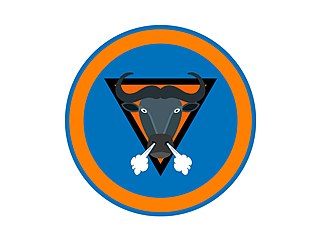
No. 120 Squadron was a joint Dutch and Australian squadron of World War II. The squadron was first formed in December 1943 as part of the Royal Australian Air Force (RAAF), and saw combat in and around New Guinea during 1944 and 1945 equipped with P-40 Kittyhawk fighters. Following the war, No. 120 Squadron was transferred to the Netherlands East Indies Air Force in 1946 and participated in the Indonesian National Revolution.
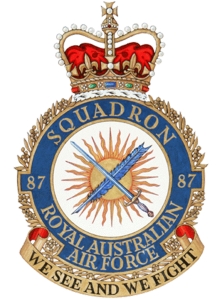
No. 87 Squadron is a Royal Australian Air Force (RAAF) air intelligence squadron. It saw action during World War II as a photo reconnaissance squadron, being raised in September 1944 through the re-designation of No. 1 Photo Reconnaissance Unit, which had been formed in June 1942. Throughout the war, No. 87 Squadron flew a variety of aircraft from bases in Australia, gathering photographic intelligence on Japanese forces and installations throughout the Pacific. At the conclusion of hostilities, the squadron was disbanded but was later re-formed in 1948, carrying out aerial survey operations in Australia until 1953. In 2006, it was re-raised again as a non-flying squadron tasked with air intelligence analysis as part of the Information Warfare Directorate within the RAAF's Air Warfare Centre.

No. 12 Squadron was a Royal Australian Air Force (RAAF) general purpose, bomber and transport squadron. The squadron was formed in 1939 and saw combat in the South West Pacific theatre of World War II. From 1941 to 1943, it mainly conducted maritime patrols off northern Australia. The squadron was based at Merauke in western New Guinea from November 1943 to July 1944, when it was withdrawn from operations. After being re-equipped, it operated as a heavy bomber unit from February 1945 until the end of the war. The squadron continued in this role until it was redesignated No. 1 Squadron RAAF in February 1948. The squadron was reformed in 1973 to operate transport helicopters but was again disbanded in 1989.

No. 452 Squadron is a Royal Australian Air Force (RAAF) air traffic control unit. It was established in 1941 as a fighter squadron, in accordance with Article XV of the Empire Air Training Scheme during World War II. The squadron flew Supermarine Spitfires for the entire war, initially over the United Kingdom and Nazi-occupied Europe. It was later based in Australia and the Netherlands East Indies, before being disbanded in 1945. It was re-raised in its current role in February 2011.
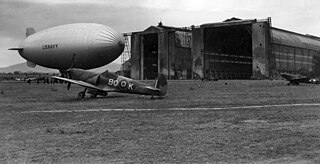
No. 451 Squadron was a Royal Australian Air Force army cooperation and fighter squadron of World War II. It was formed at Bankstown, New South Wales, on 12 February 1941 and began flying operations on 1 July as part of the North African Campaign in Egypt and Libya. No. 451 Squadron was withdrawn for refitting in early January 1942 and spent the remainder of the year performing garrison duties in Syria. In January 1943, it was transferred to Egypt to contribute to local air defence but saw almost no combat. This inactivity caused morale among the squadron's personnel to greatly deteriorate.

No. 78 Wing is a Royal Australian Air Force (RAAF) operational training wing, headquartered at RAAF Base Williamtown, New South Wales. It comprises Nos. 76 and 79 Squadrons, operating the BAE Hawk 127 lead-in fighter, and No. 278 Squadron, a technical training unit. No. 79 Squadron, located at RAAF Base Pearce, Western Australia, is responsible for converting new pilots to fast jets, while No. 76 Squadron at Williamtown conducts introductory fighter courses; both units also fly support missions for the Royal Australian Navy and the Australian Army.

No. 81 Wing is responsible for operating the Lockheed Martin F-35 Lightning II multi-role fighters of the Royal Australian Air Force (RAAF). Headquartered at RAAF Base Williamtown, New South Wales, the wing comprises three combat units, Nos. 3 and 77 Squadrons based at Williamtown and No. 75 Squadron at RAAF Base Tindal, Northern Territory, as well as an operational conversion unit at Williamtown. No. 81 Wing headquarters oversees squadron training in air-to-air and air-to-ground tactics, and support for the Australian Army and Royal Australian Navy. Tasked with offensive and defensive counter-air operations, the Hornets have been deployed to Diego Garcia in 2001–02, when they provided local air defence, to Iraq in 2003, when they saw action flying fighter escort and close air support missions in concert with Coalition forces, and to the Middle East in 2015–16, when they undertook strike operations during the military intervention against ISIL. They have also been employed to patrol high-profile events in Australia, including the Commonwealth Games and visits by foreign dignitaries.
No. 2 Security Forces Squadron is an Australian military unit whose primary role is to protect and defend airfields, buildings, equipment, and personnel.
No. 3 Security Forces Squadron (3SECFORSQN) is an RAAF Security Forces unit, whose mission is to provide security in support of air and space power assets and infrastructure.

Camden Airport is an aerodrome located on the outskirts of Sydney 1 nautical mile northwest of Camden, New South Wales, Australia. The airport is located approximately 60 km (37 mi) from Sydney's central business district. Camden is used as a general aviation overflow airport for the busier Bankstown Airport; and provides facilities for gliding and ballooning. The aerodrome has one grass- and one paved runway and two glider airstrips. It is in the south-west corner of the designated Sydney flight training area.

No. 86 Squadron was a Royal Australian Air Force (RAAF) fighter squadron of World War II. The squadron was formed in March 1943 and was deployed to Merauke in Dutch New Guinea in July that year. While No. 86 Squadron was stationed at Merauke until April 1944, it saw little combat. After being transferred back to Australia its aircraft and personnel were transferred to other units, and only a nucleus of the squadron remained. While it was re-equipped with new aircraft in June 1945, the war ended before the squadron was ready for combat and it was disbanded in December 1945.
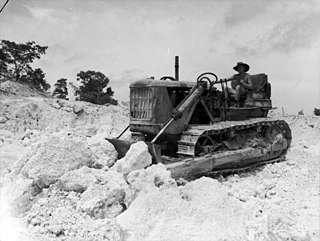
No. 5 Airfield Construction Squadron (5ACS) was a Royal Australian Air Force (RAAF) construction squadron. The unit was first formed in July 1942 and served in the New Guinea Campaign and Borneo Campaign during World War II. The squadron was one of only a few RAAF airfield construction units to be retained at the end of the war, and formed part of Australia's contribution to the occupation of Japan from 1945 until it was disbanded in June 1949. 5ACS was re-raised in August 1951 and worked on several RAAF airfields in Australia. It also provided small detachments of engineers to support RAAF deployments to South Vietnam and Thailand during the Vietnam War. The squadron was the RAAF's only airfield construction unit from 1961 onward, and was disbanded in December 1974.
RNZAF Security Forces is the Royal New Zealand Air Force unit responsible for base security, ground defence, weapons training, and Air Transport Security on RNZAF aircraft. RNZAF Security Forces operates under the RNZAF Operations Squadron.
